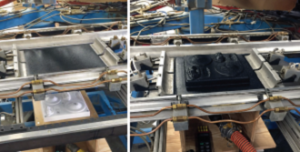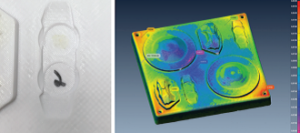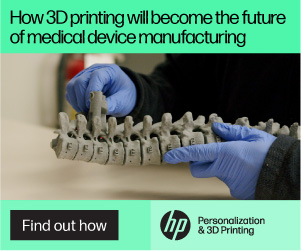
 One of the most well-known companies in the 3D printing industry, Stratasys, can call itself a leader for good reason – the company definitely knows what it’s talking about in terms of the latest additive manufacturing innovations, many of which Stratasys itself introduces.
One of the most well-known companies in the 3D printing industry, Stratasys, can call itself a leader for good reason – the company definitely knows what it’s talking about in terms of the latest additive manufacturing innovations, many of which Stratasys itself introduces.
Stratasys wants to make sure that it is sharing its expertise with the rest of the world, and published a brand new whitepaper on 3DPrint.com earlier this week.
This new whitepaper, titled “Take Advantage of the Multiple Benefits FDM Thermoform Tooling Offers,” is an FDM thermoforming design guide, and takes an in-depth look at using FDM 3D printing technology to manufacture thermoform tooling.
The description for the whitepaper reads, “Fast, cost‐efficient tool creation makes low‐volume production economical and quick customization easily viable, without sacrificing design complexity. Learn how to create FDM thermoform tooling with our comprehensive Design Guide.”

An ULTEM 9085 resin tool (left) is recommended for materials being formed over 360 °F (182 °C), such as Kydex.
Thermoforming is a manufacturing process that uses heat and pressure to bring a thermoplastic sheet or film to a pliable forming temperature. The sheet is clamped and heated to what’s known as the sag point, then formed into a specific shape inside a mold, and finally trimmed to create a usable product. The temperature needs to be high enough that the sheet can be stretched onto, or into, a mold, before it’s cooled to the final shape.
Traditionally, tooling for thermoforming has been made from materials like cast aluminum, machined aluminum billet, and even wood. However, these methods are expensive and can take a long time, which is why many thermoform part manufacturers are looking for better solutions to low- to moderate-quantity production runs. That’s where Stratasys’ FDM technology comes into play.
The technical design guide in the new whitepaper describes the procedures and techniques for designing, processing, manufacturing, and post-processing thermoform tooling using FDM 3D printing. Stratasys engineers investigated if it was feasible to lower lead times, material waste, and tooling costs by 3D printing thermoforming tools, and completed a series of lifecycle testing with ABS and Kydex thermoforming materials formed over 3D printed tools.
- PC tool being raised into the heated ABS sheet (L) and forming the ABS part over the PC mold (R).
- The surface of the PC tool after 6 Kydex forming cycles (L)and a scan comparison of the tool (R) after 6 cycles to the base scan at a scale of ±0.050 inch (1.27 mm).
When the engineers paired these materials with 3D printing ones, such as polycarbonate, ABS, and ULTEM 9085 resin, they gained a more clear understanding of, as the whitepaper puts it, “the design criteria needed to meet specific application needs from various industries such as aerospace and automotive.”
 Stratasys also assessed the six main drivers of AM technology to see just how well it can improve thermoform tooling:
Stratasys also assessed the six main drivers of AM technology to see just how well it can improve thermoform tooling:
- Economic Low-Volume Production
- Life Cycle Sustainability
- Increased Part Functionality
- Supply Chain Realignment
- Cost Effective Product Customization
- Increased Product Complexity
The new Stratasys whitepaper concludes that FDM thermoform tooling is a simpler, less expensive way to produce low-volume thermoformed parts. If you are interested in learning more about about how Stratasys’ FDM technology can enable more design freedom and other benefits in the thermoforming industry, you can download the whitepaper for free here.
Discuss this and other 3D printing topics at 3DPrintBoard.com or share your thoughts in the Facebook comments below.
[Images: Stratasys]
Subscribe to Our Email Newsletter
Stay up-to-date on all the latest news from the 3D printing industry and receive information and offers from third party vendors.
You May Also Like
3D Printing Unpeeled: New Arkema Material for HP, Saddle and Macro MEMS
A new Arkema material for MJF is said to reduce costs per part by up to 25% and have an 85% reusability ratio. HP 3D HR PA 12 S has been...
3D Printing News Briefs, January 20, 2024: FDM, LPBF, Underwater 3D Printer, Racing, & More
We’re starting off with a process certification in today’s 3D Printing News Briefs, and then moving on to research about solute trapping, laser powder bed fusion, and then moving on...
3D Printing Webinar and Event Roundup: December 3, 2023
We’ve got plenty of events and webinars coming up for you this week! Quickparts is having a Manufacturing Roadshow, America Makes is holding a Member Town Hall, Stratafest makes two...
Formnext 2023 Day Three: Slam Dunk
I’m high—high on trade show. I’ve met numerous new faces and reconnected with old friends, creating an absolutely wonderful atmosphere. The excitement is palpable over several emerging developments. The high...


































